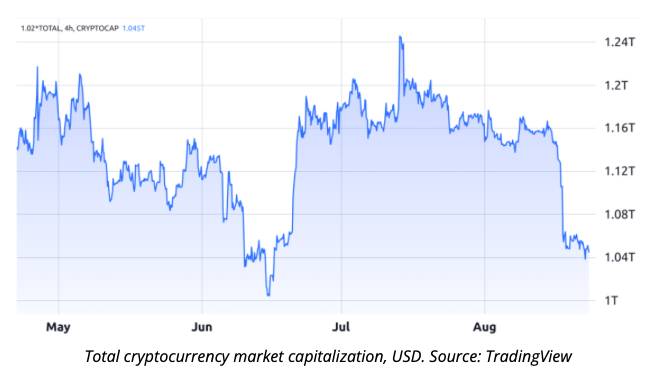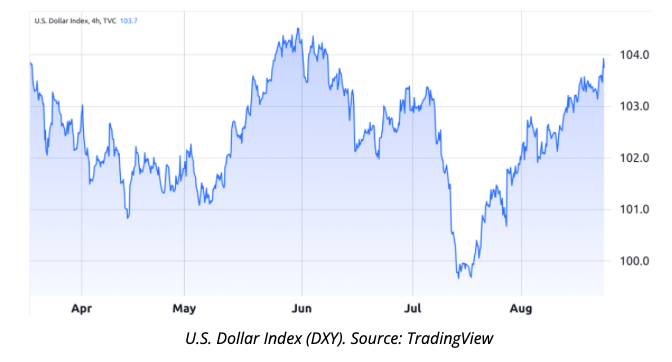In recent times, the crypto market has witnessed a significant decline, as the overall market capitalization dropped by 10% from August 14 to August 23. This decline led the market to its lowest value in more than two months, settling at $1.04 trillion. Consequently, this movement has instigated notable liquidations in futures contracts, marking the largest occurrence since the FTX collapse in November 2022.

Numerous economic factors have contributed to this downturn. With interest rates surpassing the 5% threshold and inflation persistently exceeding the targeted 2%, the costs of borrowing have surged for both households and businesses. This situation has exerted pressure on consumer spending and economic growth, resulting in reduced funds available for savings. Consequently, individuals might be compelled to liquidate their investments merely to meet their monthly financial obligations.
Given the projection of a 3.6% inflation rate for 2024 and a year-over-year increase of 5.5% in average hourly earnings – the highest rate since 2020 – it is likely that the Federal Reserve will uphold or potentially raise interest rates in the coming months. Such an environment of elevated interest rates favors fixed-income investments, which can negatively impact the appeal of cryptocurrencies.
Inflation, which previously peaked at 9%, has subsided to the current 3%, and the S&P 500 Index is only 9% below its historical peak. This scenario could signify a controlled economic slowdown orchestrated by the Federal Reserve, hinting at a reduction in the likelihood of a prolonged and severe recession. As a result, this temporarily undermines Bitcoin’s role as an investment hedge.
Factors emerging from the cryptocurrency industry
Anticipations among investors had been riding high for the approval of a Bitcoin exchange-traded fund (ETF) on the spot market, especially with endorsements from heavyweight players like BlackRock and Fidelity. However, these aspirations were shattered when the United States Securities and Exchange Commission (SEC) chose to further postpone its decision, citing concerns about inadequate safeguards against market manipulation. Adding complexity, a substantial amount of trading continues to transpire on unregulated offshore exchanges utilizing stablecoins, casting doubt on the legitimacy of market activities.
Financial troubles within the Digital Currency Group (DCG) have also cast a negative shadow. A DCG subsidiary is grappling with a debt that exceeds $1.2 billion owed to the Gemini exchange. Moreover, Genesis Global Trading recently declared bankruptcy due to losses incurred from the collapses of Terra and FTX. This delicate situation might lead to compelled selling of holdings in the Grayscale Bitcoin Trust if DCG falls short of meeting its obligations.
Further exacerbating the market’s challenges is the tightening grip of regulations. The SEC has lodged a series of allegations against Binance and its CEO, Changpeng “CZ” Zhao, accusing them of deceptive practices and operating an unregistered exchange. Similarly, Coinbase is under regulatory scrutiny and faces a lawsuit centered around the classification of specific cryptocurrencies as securities, underscoring the ambiguity in U.S. securities policy.
The U.S. dollar is gaining strength even in the face of a global economic slowdown.
Indications of trouble arising from diminished growth in China have also come to the forefront. Economists have downwardly revised their growth predictions for the nation, as both imports and exports have undergone declines in recent months. In the second quarter, foreign investments into China plummeted by more than 80% compared to the previous year. Adding to the concerns, outstanding debts from private Chinese developers have accumulated to an astonishing $390 billion, presenting a substantial menace to the economy.
Despite the potential for a deteriorating global economy, which might enhance Bitcoin’s appeal due to its scarcity and unchanging monetary policy, investors are demonstrating a preference for seeking refuge in U.S. dollars. This trend is observable in the trajectory of the U.S. Dollar Index (DXY), which has surged from its low point of 99.5 on July 17 to its current level of 103.8, marking its highest position in over two months.

While the cryptocurrency market grapples with these intricate challenges, the fluctuation of diverse economic variables and shifts in regulatory landscapes will unquestionably play a pivotal role in influencing its course over the upcoming months.
This scenario might potentially arise from an excess of optimism that followed the submission of numerous spot Bitcoin ETF applications in mid-June. Instead of concentrating solely on the factors behind the recent 10% downturn, one could contemplate whether the surge in mid-July, taking the market capitalization from $1.0 trillion to $1.18 trillion, was substantiated from the outset.


